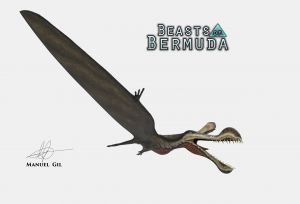Difference between revisions of "Tropeognathus"
| Line 1: | Line 1: | ||
[[File:Stub.png|center]] | [[File:Stub.png|center]] | ||
| − | + | {{Flyer | |
| + | | image =[[Image:Tropeognathus.jpg|300px]] | ||
| + | | name = Tropeognathus | ||
| + | | species = | ||
| + | | timeperiod = | ||
| + | | height = | ||
| + | | length = | ||
| + | | weight = | ||
| + | | diet = | ||
| + | | category = | ||
| + | | stance = | ||
| + | | family = | ||
| + | | health | ||
| + | | damage = | ||
| + | | speed = | ||
| + | | flightspeed = | ||
| + | | stamina = | ||
| + | | foodcapacity = | ||
| + | | growthrate = | ||
| + | | resistance = | ||
| + | }} | ||
Tropeognathus is the second [[Flying Creatures|flying creature]] to be confirmed, after [[Pteranodon]]. | Tropeognathus is the second [[Flying Creatures|flying creature]] to be confirmed, after [[Pteranodon]]. | ||
| Line 7: | Line 27: | ||
As the largest and most powerful of the [[fish]] eating Pterosaurs in Beasts of Bermuda, Tropeognathus is able to use its huge wingspan to stay airborne for long periods of time, even during all but the harshest of [[Weather|storms]]. Its large wings also allow it to be a very effective [[Swimming|swimmer]] and can repel and even [[Injury|injure]] other fliers who come too close, but this [[size]] comes at a cost; it requires a large amount of [[stamina]] to take off, especially from the water, and is slow and ungainly on the land. As a [[Piscivorous Creatures|piscivore]], it is unsuited to combat and inflicts very little [[damage]]. Tropeognathus also benefits from being in a mated pair much like an albatross or bald eagle, gaining a mild boost to a few important stats when in proximity. It will be the 'king of the skies'. | As the largest and most powerful of the [[fish]] eating Pterosaurs in Beasts of Bermuda, Tropeognathus is able to use its huge wingspan to stay airborne for long periods of time, even during all but the harshest of [[Weather|storms]]. Its large wings also allow it to be a very effective [[Swimming|swimmer]] and can repel and even [[Injury|injure]] other fliers who come too close, but this [[size]] comes at a cost; it requires a large amount of [[stamina]] to take off, especially from the water, and is slow and ungainly on the land. As a [[Piscivorous Creatures|piscivore]], it is unsuited to combat and inflicts very little [[damage]]. Tropeognathus also benefits from being in a mated pair much like an albatross or bald eagle, gaining a mild boost to a few important stats when in proximity. It will be the 'king of the skies'. | ||
| − | + | The model is WIP for this creature, and cannot be shown at this time. | |
| − | |||
| − | |||
| − | + | This creature has started animations!! | |
Revision as of 11:09, 1 October 2020
| Tropeognathus | |
|---|---|

| |
| Name Meaning: | Tropeognathus |
| Length: | |
| Weight: | |
| Diet: | |
| Category: | |
Tropeognathus is the second flying creature to be confirmed, after Pteranodon.
Not much is know yet about this animal in terms of function in Beasts of Bermuda. However, the following developer quote has been said about the animal.
As the largest and most powerful of the fish eating Pterosaurs in Beasts of Bermuda, Tropeognathus is able to use its huge wingspan to stay airborne for long periods of time, even during all but the harshest of storms. Its large wings also allow it to be a very effective swimmer and can repel and even injure other fliers who come too close, but this size comes at a cost; it requires a large amount of stamina to take off, especially from the water, and is slow and ungainly on the land. As a piscivore, it is unsuited to combat and inflicts very little damage. Tropeognathus also benefits from being in a mated pair much like an albatross or bald eagle, gaining a mild boost to a few important stats when in proximity. It will be the 'king of the skies'.
The model is WIP for this creature, and cannot be shown at this time.
This creature has started animations!!
